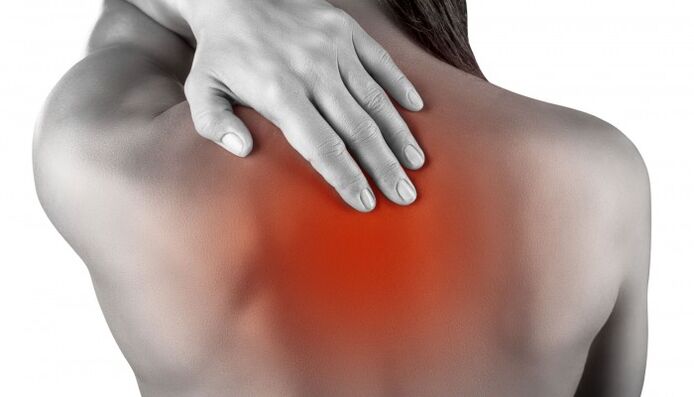Osteochondrosis of the thoracic spine is much rarer compared to similar pathology affecting adjacent segments. This is due to the strengthening of the chest - a strong and flexible frame made of ribs supports the intervertebral joints well. Even if osteochondrosis develops in this segment, it rarely occurs in the late stages. The ribs partially relieve the cartilaginous discs, preventing them from collapsing under intense and prolonged stress.
Chest osteochondrosis often develops in men - they naturally have to do harder and more harmful work. But if a woman is in similar working conditions, then the risk of osteochondrosis increases dramatically. Female ligaments and muscles are naturally more flexible and stretchy, which protects the weaker sex from degenerative chest damage.
In men, on the contrary, already in adulthood there is an "ossification" of all mobile joints - first of all, such changes are observed on the intercostal joints. Therefore, the clinical picture develops gradually, because it is associated with slow joint damage between ribs and vertebrae. the person finds the first symptoms of osteochondrosis in the chest, this subsequent treatment will be more effective and shorter.
Symptoms
Osteochondrosis in the chest rarely occurs even without small manifestations, but in the early stages patients usually simply do not notice the signs of the disease. Any discomfort is attributed to banal fatigue that has arisen as a result of prolonged work or uncomfortable posture. But the symptoms of osteochondrosis of the thoracic spine have an insidious property - they develop in a big leap.
That is, the progression of manifestations does not happen gradually, but suddenly - under the influence of any external factors. Their development is subject to a specific mechanism that occurs in the joints between the vertebrae and ribs:
- During a person's life, the mobility of the chest decreases - this is due to the thickening of the connective tissue that connects the adjacent bones.
- Due to the long and heavy load, metabolic products accumulate in it, which leads to damage to "soft" structures - ligaments and cartilage.
- In the intercostal joints, they begin to be replaced by bone tissue, which creates small growths at the site of the defect.
- First, these spines begin to irritate the nerve roots that exit the adjacent spinal cord. The impact on them results in a reflex contraction of the surrounding muscles - a spasm.
- It worsens impaired mobility, making the rib less flexible and elastic. These changes change the nutrition of the surrounding tissues as their blood supply deteriorates.
- Gradually, a vicious circle is created - impaired blood flow deprives soft tissues of the possibility of quick recovery. If the burden continues to work, then osteochondrosis of the thoracic spine gradually develops.
The rate of disease progression depends on the severity of the harmful factors and the capabilities of the body - in most patients it remains at an early stage until old age.
First degree

It is difficult to establish thoracic osteochondrosis in the early stages - the symptoms of the disease are still too non-specific. Most patients miss the first stage of the disease, going to the doctor only when serious symptoms develop. But with a careful attitude towards your health, the signs of pathology can be easily recognized:
- Because the soft tissues are compacted in the area of the joints between the ribs and the vertebrae, their flexibility and elasticity decline. Therefore, when stretching or performing exercises, there is pain and cramping in the thoracic region, which occur between the shoulder blades.
- A similar sound can be heard in the collarbone or sternum, where cartilage and connective tissue are also thickened.
- Together with them, the flexibility of the shoulder girdle is impaired, which is manifested by difficulties in placing the arms behind the back. It becomes difficult for the patient to perform some movements - scratching his back, gathering his shoulder blades.
- The feeling of discomfort is in any part of the chest, but more often in the interscapular region. On it is projected the bulk of the nerve roots exiting the spinal cord in this section.
- Resistance to prolonged physical work and posture decreases - a feeling of fatigue in the back occurs quickly.
- The depth of breathing decreases - when you try to take a deep breath, its limitation is noticed.
At this stage, the disease can be safely treated at home, because there are still no irreversible changes in the soft tissues in the joint area.
Second degree

While the influence of negative factors continues, the signs of osteochondrosis in the chest begin to intensify - at this stage patients usually seek help. The disease begins to significantly limit human activity - the symptoms are disturbed not only during work, but also during rest. Their appearance is associated with the creation of permanent changes that lead to ossification of the rib-vertebral joints:
- The pain, which is the result of pressure on the nerve roots, is already coming to the fore among the symptoms. It has some characteristics - the character of burning or shooting, a connection with physical activity or long-term uncomfortable posture.
- Unpleasant sensations are usually determined between the shoulder blades, from where they spread along the ribs. The impulse of pain is always one-sided.
- The intensity of this symptom depends entirely on the movements of the torso or breathing - even with calm breathing, increased pain is noticed.
- The disease differs from the usual intercostal neuralgia in the duration of the symptoms - in the first case, the pain syndrome passes on its own and quickly (within a few minutes). Osteochondrosis of the thoracic spine differs in the duration of pain - they are continuous and decrease only at rest.
- Chest discomfort and stiffness increase, leading to a decrease in exercise tolerance. It becomes more difficult for the patient to do the work associated with long-term stress.
At home, it is almost impossible to eliminate the symptoms at this stage - they try to use a long course of medication, combined with physiotherapy procedures, for treatment.
Third degree

In the final stage of the disease there is a strong deformation of the joints between the ribs and the vertebrae. This puts pressure on the surrounding vessels and nerves that are directed to the internal organs. Therefore, the symptoms of the disease take on unusual features characteristic of another pathology:
- The pain syndrome continues, taking on an intense and continuous character. Lumbago between the shoulder blades and along the ribs bothers the patient even at rest, which is associated with constant pressure on the nerve roots.
- There are areas of impaired sensitivity on the abdomen and chest - they look like stripes along the direction of the ribs. They are characterized by numbness, tingling or "creeping".
- Occasionally there are reflex spasms of the abdominal muscles, followed by unpleasant sensations.
- Because the nerves of the internal organs are involved in the process, symptoms of their defeat may occur. False attacks of angina pectoris, liver or renal colic, which simulate diseases of similar organs, are more common.
- Chest osteochondrosis often leads to the formation of irritable bowel syndrome - a disorder of the digestive tract, the causes of which are not determined during the examination.
Even long-term treatment will not allow you to permanently get rid of the symptoms if the patient has adhered to the disease to such an extent. Supportive therapy will only reduce the signs of a disease that is firmly rooted in the thoracic spine.
Treatment
How to treat osteochondrosis of the chest? The tactics of providing help are based on the duration of the disease - the more pronounced the symptoms, the more phases will include the treatment of osteochondrosis of the thoracic spine. Despite frequent difficulties in prescribing medications, many patients want to perform all treatment procedures at home. The patient does not want to waste the unnecessary time needed to visit the hospital or clinic.
In addition, sick leave is rarely issued for this disease, which forces people to quickly leave the started activities. Feeling a certain improvement, the recent patient returns to his usual activities. But incomplete treatment of breast osteochondrosis leads to a rapid return of previous symptoms. Therefore, too "busy" patients can perform some procedures at home - the main thing is not to give up.
At home
You can only go to the hospital in the early stages of the disease, when all the changes in the spine are reversible. With the help of some measures it is possible to eliminate muscle spasm, which is the cause of manifestations:
- It is necessary to change the place of rest - the bed on which the soft tissues of the spine are renewed during sleep. To do this, you need to make it stiff, buy an orthopedic mattress to rule out the wrong back position.
- For any activity, you need to use a support for the spine - a soft corset that covers the lumbar and thoracic region. It should be worn to work regularly, taking off only when you are resting or sleeping.
- It is recommended to use warming ointment to relieve symptoms. They are applied between the shoulder blades before the oncoming load to artificially warm up the muscles.
- You need to get into the good habit of doing exercises at home after waking up. Moreover, it is not necessary to perform it only in the morning - for any discomfort in the back you need to find a few minutes to warm up.
- You need to change your diet, increase the amount of vegetables and fruits in your diet - the vitamins they contain slow down the destruction of connective tissue.
Patients who have enough free time are advised to engage in physical activity - walking or swimming.
Conservative

With the development of pronounced signs, the treatment of osteochondrosis of the thoracic spine begins with the help of medication. They allow you to eliminate pain and other manifestations that interfere with normal activity:
- First of all, anti-inflammatory drugs that have an analgesic effect are prescribed. They inhibit the processes of soft tissue destruction, which inevitably leads to the formation of bone growths.
- Muscle relaxants are also used - drugs that remove painful muscle contractions. Their use allows the chest to return to its former flexibility and mobility.
- Furthermore, vitamin complexes are prescribed with the aim of protecting the nervous tissue. They allow you to quickly regenerate the roots of the spinal cord that were exposed to pressure.
- Painkillers and anti-inflammatory agents can also be used in the form of creams that are applied between the shoulder blades. But they are usually combined only with drugs to ensure synergy.
The course of medication usually lasts from 2 to 3 weeks, after which the patient is switched to home treatment.
Surgically

Surgical treatment is usually used when the drugs are ineffective. Moreover, the intervention is not always radical in nature:
- The most commonly used blockade is the introduction of drugs with a needle directly into the lesion. A local anesthetic is usually used to relieve symptoms. After the procedure, the effect lasts for several days.
- Blockades performed with the help of glucocorticosteroids are more effective - they provide a therapeutic effect that lasts for several weeks. The composition contains hormones that suppress the inflammatory process in the area of application.
- In the most severe cases, surgery is performed - removal of deformed areas of the joints between the ribs and the vertebrae. In this way, it is possible to eliminate the pressure on the nerve roots and blood vessels, which leads to the removal of most manifestations.
Surgical correction does not lead to a complete cure of the disease, but only alleviates the patient's condition. Therefore, after any manipulation, it is necessary to continue conservative therapy aimed at slowing down the progression of the disease.
Rehabilitation
Elimination of the main signs of osteochondrosis does not mean the end of treatment. In the period after treatment, the patient undergoes restorative measures:
- In the initial period, procedures that have a reflex effect are prescribed. Electrophoresis and phonophoresis, UHF and laser can eliminate reflex muscle contraction in the thoracic spine.
- Then more active procedures begin - massage, therapeutic exercises. They help strengthen the muscular frame of the chest.
- Recovery ends with independent training, which should last in a continuous mode. They allow you to slow down the progression of osteochondrosis.
Such patients are advised to choose sports that allow them to develop endurance and muscle strength at the same time. Therefore, patients are advised to engage in swimming and running, which allows you to evenly load all the muscles. Daily trainings are not obligatory - three sessions a week are enough.



































